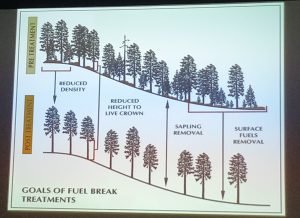The West Creston Fire Department attended a seminar hosted by Area C Director Adam Casemore regarding measures to mitigate destruction caused by wildfires.
The presentation kicked off with Chris Johnson, Emergency Program Manager for the Regional District of Central Kootenay giving a full presentation about the FireSmart program, outlining its benefits to West Creston Fire rescue staff.
He gave examples of how ground fires can ignite and destroy entire neighbourhoods due to poor material choices, shrubs and tree placement. In a series of tests and data collected from real-life scenarios, including the Fort McMurray disaster, Johnson displayed the risk that firebrands (flying embers) pose to neighbourhoods.
In the video below at the 2-minute mark, embers can be seen igniting shrubs that lead to houses catching fire.
https://www.youtube.com/watch?v=UeCNL55KB1Y
According to Johnson, firebrands are the number 1 cause for the complete destruction of neighbourhoods. He said FireSmart engineers can help homeowners mitigate the risk of ignition by up to 95 per cent.
“Really when you look at what is the home ignition zone, you’re looking at trying to remove flammable substances on surfaces,” explained Johnson. “The first step would probably be to book one of these assessments because then you can have a professional that can deliver a high technical level of service that can walk you through that as they do the assessment.”
Cathro Consulting wildfire expert Mark Elder was also in attendance and gave a presentation about the areas most at risk around electoral areas A, B and C.

He explained that the region is a fire-dominated ecosystem and that fire is as much a part of the solution as it is a part of the problem.
Elder said the burning of ground fuels is an important process since if it gets overgrown, more dangerous crown fires can spread, causing more destruction.
“Typically fires in some areas will go through the forest between every 10 and 80 years approximately. So, if the fires are routinely going through there and get all the surface fuels, it will have less of an intense fire in that area and probably won’t create a class 5 fire, a crown fire we call it.”

This process can be done by machine or hand where smaller controlled burns remove fuels. However, it can be costly with each hectare of land cleared costing up to $10,000. Another distinct feature that raises alarm about the Creston Valley is the diverse “stand” of trees. Because of the variety of tree species and height differential in the forest, fires have a “ladder” to climb, potentially reaching the crown of trees.
Elder proposed a partnership wherein selective logging at 60 per cent retention would thin out fuels and create the fire breaks necessary to protect the Wildfire Urban Interface (WUI), the zone that connects communities to the forest.
Ultimately, Elder said identifying zones that need protecting is a collaborative effort.
“We’re here to inform the public on the process that we are identifying these areas. Any input that they may have on the process, any areas that they want to see protected, but it’s a collaborative from everywhere from the public, people on the ground all the way up to the regional district officials. Local government to provincial government as well.”
Director Casemore plans for a second meeting to gather support for the project. The meeting will likely be in January, more details to follow.

